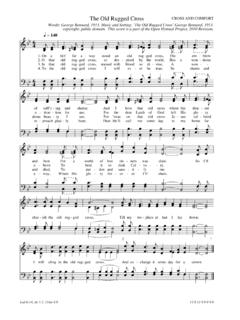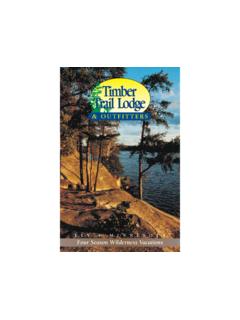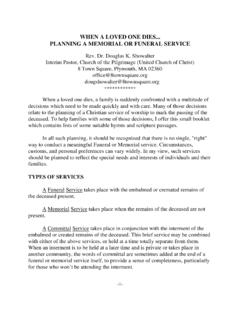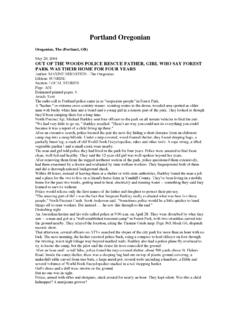Transcription of Classic Australian Australian Identity Unit
1 Classic Australian literature: Australian Identity unit Featuring the ballads of Banjo Paterson & Henry Lawson Suitable for Grades 8,9 & 10 Contains: Text, Themes, Poetry Analysis questions, Activities, Teacher s Guide, Assessment Topics and Australian Curriculum Outline In this lesson series students will focus on Australian poetry in particular the ballad form found in the poems of Lawson and Paterson. Students will understand the characteristics of the ballad and the vocabulary and language of early poetry and gain insight into the cultural and social context of the time.
2 Teacher s summary Andrew Barton Paterson was born in 1864 in NSW. The first publication of his poetry came in 1889 when the Sydney Bulletin placed Clancy of the Overflow by The Banjo in its edition. It was followed in 1895 by Banjo s the Man from Snowy River. His bush ballads were typical of the bush life and his writing has a special connection to the times in which it was written. The Bulletin in 1880 was encouraging Australians everywhere to write about life in the outback and the new country was searching for an Identity .
3 Banjo s Waltzing Matilda had become a more popular anthem for Australians in the way it captures a heroic pioneer adventurer as its main character and idolises the spirit of the bush . Banjo s poetry chronicles the common life in the outback with comedy and sardonic acceptance of the good with the bad. Henry Lawson is described as the people s poet or bush bard . Born in 1867 he is Australia s best known poet and fiction writer. His work contains themes of sadness and hardship inspired as they were by his own upbringing in poverty and bouts of alcoholism.
4 He wrote copious ballads, lyrics, radical songs, sketches and stories which appeared in journals and published in collection form in Australia and England. Some well known ballads include Freedom on the Wallaby ,A Song of the Republic, the Drover s Wife and The Old Bark school The National Library of Australia TROVE is an archival collection that contains many resources that will aid the students in their research of the social context of these ballads. They have images, documents and newspaper articles of both Paterson and Lawson as well as indigenous issues and photographs.
5 Poetry analysis The acronym SMILES is a useful means of covering all aspects of poetry analysis for the high schooler S structure how is the poem organised? How many stanzas or verses are there? What is the rhyming scheme? Ie ABAB (each rhyming set is named by a consecutive letter) How do the ideas progress? What is the line length in syllables? Is there repetition of words and or phrases? M meaning look at the title what does it suggest the poem means? Is there an overall theme? What is the main subject? Does it have a message?
6 I imagery what visual picture do you think of when reading it? Describe the imagery used eg: metaphor, simile, personification, symbolism L language what words are used are they simple or complex? Serious or ironic? Is it lyrical and flowing? Colloquial/slang or proper English? Are there any interesting grammatical features or punctuation? E effect what opinion is presented by the author/narrator? Is there a particular tone used? What do you feel when you read it, what is your response? S sound what sounds are evident onomatopoeia, alliteration, consonance or assonance by Henry Lawson (1867-1922) It was built of bark and poles, and the floor was full of holes Where each leak in rainy weather made a pool; And the walls were mostly cracks lined with calico and sacks There was little need for windows in the school.
7 Then we rode to school and back by the rugged gully-track, On the old grey horse that carried three or four; And he looked so very wise that he lit the master's eyes Every time he put his head in at the door. He had run with Cobb and Co. "that grey leader, let him go!" There were men "as knowed the brand upon his hide", And "as knowed it on the course". Funeral service: "Good old horse!" When we burnt him in the gully where he died. And the master thought the same. 'Twas from Ireland that he came, Where the tanks are full all summer, and the feed is simply grand; And the joker then in vogue said his lessons wid a brogue 'Twas unconscious imitation, let the reader understand.
8 And we learnt the world in scraps from some ancient dingy maps Long discarded by the public-schools in town; And as nearly every book dated back to Captain Cook Our geography was somewhat upside-down. It was "in the book" and so well, at that we'd let it go, For we never would believe that print could lie; And we all learnt pretty soon that when we came out at noon "The sun is in the south part of the sky." And Ireland! that was known from the coast-line to Athlone: We got little information re the land that gave us birth; Save that Captain Cook was killed (and was very likely grilled) And "the natives of New Holland are the lowest race on earth".
9 And a woodcut, in its place, of the same degraded race Seemed a lot more like a camel than the blackfellows that we knew; Jimmy Bullock, with the rest, scratched his head and gave it best; But his faith was sadly shaken by a bobtailed kangaroo. Pop quiz Bush christening Spalpeen rascal Prog poke Aisy easy Praste proper etiquette, social niceties Language uncivil swearing, oath Collogue conversation Dolts dumb, stupid Man in the frock minister, reverend Divil devil But the old bark school is gone, and the spot it stood upon Is a cattle-camp in winter where the curlew's cry is heard; There's a brick school on the flat, but a schoolmate teaches that, For, about the time they built it, our old master was "transferred".
10 But the bark school comes again with exchanges 'cross the plain With the Out-Back Advertiser; and my fancy roams at large When I read of passing stock, of a western mob or flock, With "James Bullock", "Grey", or "Henry Dale" in charge. And I think how Jimmy went from the old bark school content, With his "eddication" finished, with his pack-horse after him; And perhaps if I were back I would take the self-same track, For I wish my learning ended when the Master "finished" Jim. Themes; schooling & education what eddication is the narrator referring to in the last stanza?













